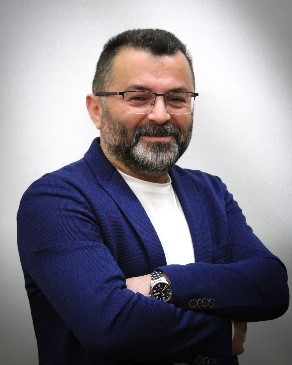GENERAL SEMINAR – Prof. Dr. ALI CIRPAN, Department of Chemistry, Middle East Technical University, Ankara Turkey
Conjugated polymers (CPs) are large organic macromolecules with a repeating pattern of alternating σ and π bonds along their main chain. They merge the advantageous characteristics of plastics, such as flexibility, processability, and lightweight nature, with their inherent semiconducting properties. Before the development of CPs, polymers were regarded as electrical insulators. However, CPs possess distinctive electrical and optical properties due to the highly delocalized and electron-dense π bonds in their structure. The application of CPs has revolutionized the fields of organic solar cells (OSCs) and organic light-emitting diodes (OLEDs), offering a promising avenue for advancing renewable energy and display technologies.
In the realm of OSCs, CPs are important in enhancing the efficiency of OSCs due to their distinctive electronic and structural attributes. The tunable energy levels of CPs contribute to efficient charge transport and separation, vital for achieving high open-circuit voltage (VOC) in OSCs. By tailoring CPs into donor-acceptor systems, efficient charge separation is achieved, amplifying electron transfer to acceptor materials and further refining device efficiency. The compatibility of CPs with solution-based processing techniques enables cost-effective and scalable OSC fabrication, fostering versatility for integration into various applications. Ultimately, CPs enable lightweight, flexible OSC design for wearable electronics and portable energy sources while offering material diversity and interface engineering possibilities, thereby underscoring their significance in advancing sustainable energy technologies.
OLEDs exhibit smart features including sleek design, excellent image quality, and lightweight nature, making them self-illuminating devices. They have gained widespread recognition due to their incorporation in smartphones and large TV displays. OLEDs can be made from small molecules or polymers, with vacuum deposition used for the former and solution deposition for polymer-based organic light-emitting diodes (PLEDs). The cost-effective and simplified process of PLED fabrication, often conducted at room temperature, has attracted attention. This method allows flexible organic substrates to serve as a platform for device creation. Furthermore, with the discovery of thermally activated delayed fluorescence (TADF) materials, research interest towards OLEDs were vitalized. 2-Component or 3-component combinations of high performance red, green, yellow and blue colored emitters have been used to produce white OLEDs. Similar to OSCs, in the domain of OLEDs, CPs have emerged as indispensable materials for achieving efficient electroluminescence and color emission. Their conjugated backbone allows for efficient electron and hole injection, resulting in balanced charge transport and reduced exciton quenching. The tunable emission wavelengths of CPs make them versatile candidates for producing a wide range of colors in OLED displays.
In conclusion, CPs have emerged as indispensable components in the development of high-performance OSCs and OLEDs. Their remarkable electronic properties and compatibility with solution processing techniques have paved the way for innovative approaches to renewable energy generation and advanced display technologies.
Prof. Dr. Ali Cirpan obtained his B.S. in Chemistry (1998) followed by his M.S. (2000) and Ph.D. (2004) at Middle East Technical University (METU). He became interested in the field of electrochromism as a visiting graduate student with the Professor John Reynolds’ Research Laboratory at the University of Florida in 2002.
After finishing his PhD in 2004 with Professor Levent Toppare at METU, he joined the Professor Frank E Karasz research group as a Postdoctoral Associate, at the Department of Polymer Science and Engineering, University of Massachusetts, where he developed light emitting devices using new organic or inorganic materials for two and a half years.
From January 2007 to December 2008, he has worked on fabrication and characterization of photovoltaic devices in Professor Thomas P. Russell’s group, at the University of Massachusetts. He then joined the Articulated Technologies, LLC in Wallingford, Connecticut.
Prof. Ali Cirpan returned to Middle East Technical University as an Assistant Professor in 2009. In 2011 he was promoted to Associate Professor at METU in the Department of Chemistry. He is currently a Full Professor in the Departmet of Chemistry at Middle East Technical University, Ankara, Turkey. Dr. Cirpan’s research focuses on optoelectronic materials, morphologies and devices especially Solar Cell, OLEDs, ECDs, Supercapacitors.